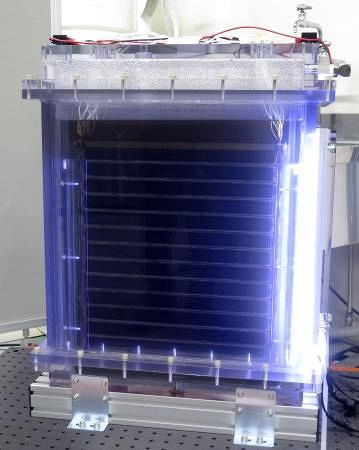

Toyota: Solar conversion efficiency by artificial photosynthesis 7.2%: Formic acid synthesis at normal temperature and pressure
-Aiming to recycle CO2-
Toyota Central R & D Labs
On April 21, useful substances were synthesized from only CO2 and water using the energy of sunlight.
Artificial photosynthesis:
“Artificial photosynthesis” was carried out in a 36 cm square cell of the size of a practical solar cell.
Achieves the world’s highest solar conversion efficiency of 7.2% in this class.
This result was published in the international energy journal “Joule Vol.5, No.3,2021”.
Solar conversion efficiency 7.2%:
Artificial photosynthesis at Toyota Central R & D Labs is a method that uses semiconductors and molecular catalysts.
Combining electrodes that perform CO2 reduction reaction and water oxidation reaction,
Technology for synthesizing organic substances (formic acid) at normal temperature and pressure.
Principle demonstration in 2011:
In 2011, in the world’s first proof of principle, the solar conversion rate was 0.04%.
In 2015, with a 1 cm square size, we achieved a conversion efficiency of 4.6% (the highest in the world at that time), which greatly exceeds that of plants.
Developed new cell structure and electrodes:
Toyota Central R & D Labs used the basic principle as it was.
The electrode area was expanded to a size that is well-balanced with the amount of electrons generated by the solar cell.
Promotes formic acid synthesis:
We have developed a new cell structure and electrodes that can promote formic acid synthesis.
What are the three elements required for formic acid synthesis?
Electronic,
Hydrogen ion,
CO2,
The new cell structure and electrodes can supply three elements to the entire surface of the electrodes quickly and uninterruptedly.
resulting in:
With a practical size of 36 cm square, it achieves the world’s highest conversion efficiency of 7.2% in this class.
Future fields of use:
Toyota Central R & D Labs will collect CO2 emitted from factories in the future.
With this artificial photosynthesis, we aim to realize a system that recycles resources.
Car Watch
https://car.watch.impress.co.jp/docs/news/1320520.html
A large-sized cell for solar-driven CO2 conversion with a solar-to-formate conversion efficiency of 7.2%
February 2021Joule 5(3) DOI:10.1016/j.joule.2021.01.002
Project: CO2 conversion to useful organic chemicals
Authors: Toyota Central R & D Labs., Inc
Naohiko Kato Shintaro Mizuno. Masahito Shiozawa
Abstract
Solar-driven electrochemical (EC) reduction of CO2 to fuel using photovoltaic (PV) cells
is a promising CO2 recycling technology. However, the scale-up of EC reactors lowers the solar-to-chemical conversion efficiency (ηSTC) due to the large electric resistance of the electrode catalysts and an insufficient supply of reactants.
We designed a large-sized cell to convert CO2 to formate.
It consists of five stacked electrodes (electrically parallel connected) and six series-connected single-crystalline Si PV cells (area ∼1,000 cm²).
Low-resistivity anodes loaded with IrOx and cathodes loaded with Ru complex polymer on carbon support operate without a membrane between them at a low voltage of 1.85 V.
They generate a reaction current of 6.30 A, owing to the homogeneous flow of the CO2-dissolved electrolyte to achieve a sufficient CO2 supply and a good match between the PV and EC performances.
The cell yields a conversion efficiency of 7.2% and the high production rate of 93.5 mmol/h.
Request PDF